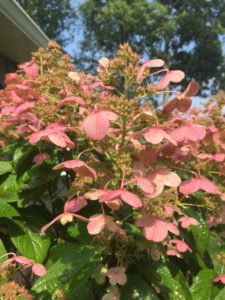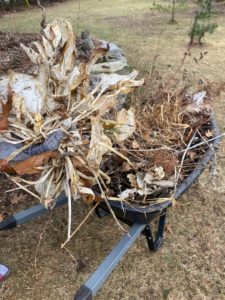Here are some general pruning rules to keep in mind:
- Prune after the shrubs have flowered. For example bridal wreath spirea which flowers in June, should be pruned right after the blooms fade. Pruning in the late summer or fall will remove the new growth and reduce the number of flowers next spring.
2. Prune Forsythia flowers in the spring. If you prune them in the fall, you will cut off all the new growth and not get flowers. Of course, if branches are damaged, or diseased or dangerous, then, prune right away.
3. As for perennials, leave as many as possible standing. The birds will appreciate the seeds from the echineacea, rudbeckia etc. through the winter. Also bugs and caterpillars nest in the stems and underside of leaves.
4. No need to cut back hostas in the fall. If you leave them, by spring the leaves have broken down and are easy to lift out of the garden and add to the compost.
5. As for hydrangeas, it really depends on the kind you have. Prune at the wrong time and you could be inadvertently cutting off next season’s flower buds. Here is information below that will help. 
The New York Botanical Garden (NYBG) explains how to properly prune the most common types of hydrangeas.
The Big Leaf (hydrangea macrophylla)
Two popular varieties, Mophead and Lacecap, come in blue, pink, and purple, with thick, shiny leaves. Mophead produces large, ball-shaped flower clusters, while Lacecap’s clusters are flat and delicate. They bloom on old wood (stems that have been on the bush since the summer before) and should be pruned in the summer when the flowers have started to fade but before August hits. A bush can be trimmed by cutting back stems close to a node. If a plant is overgrown, prune back about one-third of the older stems almost to the ground.
Oakleaf (hydrangea quercifolia)
This species has leaves that look like they belong on red oak trees and flowers that open white then turn pink. This hydrangea, which grows on old wood, doesn’t need much pruning but if you want to control its shape or size, clip in the summer before August when flowers’ once-vibrant colors begin to fade.
Smooth (hydrangea aborescens)
One variety, Annabella, has big flowers that are actually made up of many small individual blooms. They start out green but turn white a few weeks later. This species’ leaves are thinner than Mophead’s and Lacecap’s. Since it blooms on new wood (stems that have grown during the current season), prune in early spring before any flower buds have appeared.
Peegee and Limelight (hydrangea paniculata)
This white species, which blooms on new wood, is most often cone-shaped and sharply pointed. It comes in many varieties, from small shrubs to small trees. Its leaves are rough and thin. Prune in early spring before it starts flowering.
Tree of Heaven and Mountain (hydrangea serrata)
It’s got a similar look to Mophead but is a smaller shrub with narrower, pointed leaves. This flower, which blooms on new wood and can be pruned at any time after the new growth has started, is affected by a soil’s pH: It produces lilac to pink flowers in alkaline soil and blue blossoms in acidic soil.
6. The two things I try to remember in my own gardens, are to prune at the right time and if I can’t do it then, prune when I can. Also, I will learn from my mistakes, and as a gardener, I’m an optimist, and next year will always give me another chance!
authored by Judy Kaufmann

